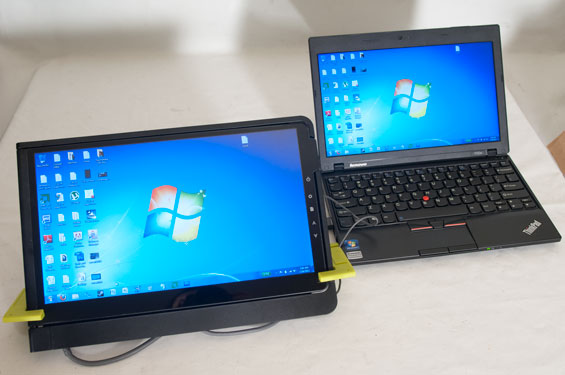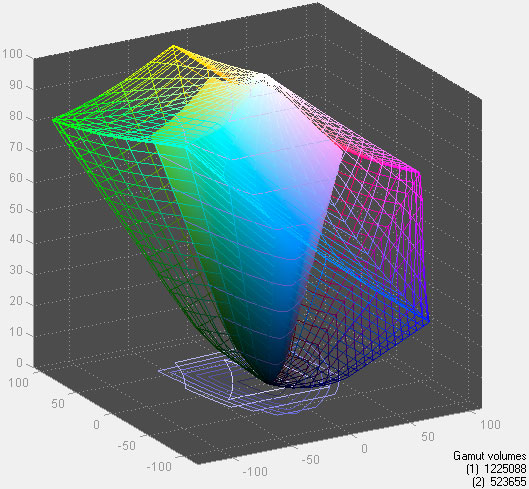Capsule Review: GeChic's On-Lap 1301 Laptop Monitor
by Dustin Sklavos on January 19, 2012 2:16 AM EST- Posted in
- Laptops
- Peripherals
- LCD
- gechic
Performance and Screen Quality
The GeChic On-Lap 1301 is a 13” screen being powered off of USB, and as a result it’s not exactly going to be a big winner on any technical merits. On NewEgg, GeChic rates the 1301’s brightness at 200 nits and the contrast ratio at 500:1, and just like the big boys they cheerfully exaggerate the screen’s capabilities. Thankfully they’re honest about color quality; because it’s a TN panel it only produces 262,000 colors. Viewing angles are in the doghouse, too, but given the size and orientation the On-Lap is expected to be used in, that’s not a major strike against it.

What does strike against the On-Lap 1301 is the use of a glossy finish instead of a matte. Understanding that gloss is fairly typical of consumer-oriented products, the On-Lap suffers mightily for its finish due partly because its “closed” position still leaves the screen exposed. Glossy screens show dirt far more easily than their matte counterparts. Worse still, that means the screen is left essentially unprotected. Given that pressing the control buttons on the back of the screen results in ripples in the display, it stands to reason the screen is neither well-reinforced nor well-protected, making its value as a travel accessory suddenly much more questionable. While the frame feels durable enough, I’d be concerned about the safety of the screen itself, especially when it’s retailing for $200.

So how does it actually rate in terms of raw performance? The On-Lap 1301 sports a maximum brightness of 142 nits, but default brightness is just 94, both well shy of the rated 200 nits. With default black levels at 0.7 nits, that works out to a contrast ratio of 134:1, again well below what GeChic rates it at. Delta-E is no better at 2.53 on average, but color gamut at least is 42.7% of AdobeRGB 1998. Outside of the low brightness (a byproduct of being powered solely off USB), you could easily mistake the On-Lap for another laptop display. That’s good news for matching it up with notebooks on the market, but also speaks to the generally dire state of notebook displays. Still, we can’t complain too much since the On-Lap doesn’t actually require an external power source and can thus be used on the battery.
And how does it handle on the battery? The display is after all typically one of the most, if not the single most power hungry part of a notebook, so we tested it on the Acer TravelMate 8481T we reviewed recently using our internet battery test. The 8481T, without powering the GeChic display, is able to run for 8:41—that’s eight hours and 41 minutes, no mean feat. Plug in the display and running time drops to 5:55. That means if you use the GeChic On-Lap, you can expect your battery running time to drop by roughly a third assuming you’re using it with a similarly-sized notebook with a similar display. Honestly that doesn’t seem so bad given that you’re driving an entire second screen.
















31 Comments
View All Comments
Kristian Vättö - Saturday, January 21, 2012 - link
USB 3.0 version would be cool as it delivers more power. It might even be enough for the data so it would be just one cable.Nihility - Saturday, January 21, 2012 - link
Don't forget that it's being powered off of the laptop battery. USB 3.0 gives you more power but that would come at the expense of battery life.MonkeyPaw - Friday, January 20, 2012 - link
I think I said a few months ago that this would be a better idea versus that 2 screen laptop that was reviewed. It allows for an extra screen, but only when you need it, and it requires no additional power source. The next step should be to put a Li-Ion battery on the back that can either power the monitor on its own, or provide reserve power for the laptop (which would require creative cabling, so probably a no-go). Either way, a thin battery would take one drawback away when it comes to portability.YukaKun - Friday, January 20, 2012 - link
Actually, the battery idea could be accomplished by adding a "backpack" to the display itself. Think of a cellphone battery width, screen size (or close to that). Should give the screen a good 10 hours of continuous use, right? It shouldn't give the display that much weight, also.I like the idea, but being productive "on the go" is a very niche market TBH (designers for the most part, maybe programmers). Hope they do well.
Cheers!
Meaker10 - Friday, January 20, 2012 - link
Hmz, it would be interesting the crack open the shell and see what kind of cables are inside as you could look into putting your own panel in.bennyg - Friday, January 20, 2012 - link
Did you test off a standard USB 2.0 port only?Could this device draw more from a USB 3 (or over-spec USB2 port like on my P150HM which can supply more than 500mA) - and thus be brighter?
Great effort for 500mA though. Hope this isn't a concept resigned to the "oh yeah whatever happened to that" bin of history.
Dustin Sklavos - Saturday, January 21, 2012 - link
Tested off of USB 2.0 and USB 3.0, makes no difference that I could see.max347 - Saturday, January 21, 2012 - link
Is there any way we could get more pictures of it on a larger laptop? I really like this idea, but would want to see how it looks installed on something. I think the 'presentation mode' would actually be useful, wherein I could show other people at a table data without having to spin the laptop back and forthchillmelt - Saturday, January 21, 2012 - link
I'd buy it if it works on a Mac Mini. Such a setup sounds like a reasonable portable desktop. The wires could use some work, but I imagine they can be removed if not used.Dustin Sklavos - Saturday, January 21, 2012 - link
No reason it wouldn't. It just draws power off a standard USB 2.0 port and then uses HDMI or VGA for a video connection.